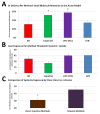A needleless liquid jet injection delivery method for cardiac gene therapy: a comparative evaluation versus standard routes of delivery reveals enhanced therapeutic retention and cardiac specific gene expression
- PMID: 25315468
- PMCID: PMC4261917
- DOI: 10.1007/s12265-014-9593-1
A needleless liquid jet injection delivery method for cardiac gene therapy: a comparative evaluation versus standard routes of delivery reveals enhanced therapeutic retention and cardiac specific gene expression
Abstract
This study evaluates needleless liquid jet method and compares it with three common experimental methods: (1) intramuscular injection (IM), (2) left ventricular intracavitary infusion (LVIC), and (3) LV intracavitary infusion with aortic and pulmonary occlusion (LVIC-OCCL). Two protocols were executed. First (n = 24 rats), retention of dye was evaluated 10 min after delivery in an acute model. The acute study revealed the following: significantly higher dye retention (expressed as % myocardial cross-section area) in the left ventricle in both the liquid jet [52 ± 4] % and LVIC-OCCL [58 ± 3] % groups p < 0.05 compared with IM [31 ± 8] % and LVIC [35 ± 4] %. In the second (n = 16 rats), each animal received adeno-associated virus encoding green fluorescent protein (AAV.EGFP) at a single dose with terminal 6-week endpoint. In the second phase with AAV.EGFP at 6 weeks post-delivery, a similar trend was found with liquid jet [54 ± 5] % and LVIC-OCCL [60 ± 8] % featuring more LV expression as compared with IM [30 ± 9] % and LVIC [23 ± 9] %. The IM and LVIC-OCCL cross sections revealed myocardial fibrosis. With more detailed development in future model studies, needleless liquid jet delivery offers a promising strategy to improve direct myocardial delivery.
Conflict of interest statement
No competing financial interests exist.
Figures






Similar articles
-
A Needleless Liquid Jet Injection Delivery Approach for Cardiac Gene Therapy.Methods Mol Biol. 2017;1521:219-226. doi: 10.1007/978-1-4939-6588-5_15. Methods Mol Biol. 2017. PMID: 27910052
-
Myocardial gene transfer and long-term expression following intracoronary delivery of adeno-associated virus.J Gene Med. 2005 Mar;7(3):316-24. doi: 10.1002/jgm.665. J Gene Med. 2005. PMID: 15515115
-
Augmentation of AAV-mediated cardiac gene transfer after systemic administration in adult rats.Gene Ther. 2008 Dec;15(23):1558-65. doi: 10.1038/gt.2008.111. Epub 2008 Jul 10. Gene Ther. 2008. PMID: 18615116
-
A single direct injection into the left ventricular wall of an adeno-associated virus 9 (AAV9) vector expressing extracellular superoxide dismutase from the cardiac troponin-T promoter protects mice against myocardial infarction.J Gene Med. 2011 Jun;13(6):333-41. doi: 10.1002/jgm.1576. J Gene Med. 2011. PMID: 21674736 Free PMC article.
-
Delivery of recombinant adeno-associated virus by jet injection.Int J Mol Med. 2003 Nov;12(5):687-91. Int J Mol Med. 2003. PMID: 14532994
Cited by
-
Liquid jet delivery method featuring S100A1 gene therapy in the rodent model following acute myocardial infarction.Gene Ther. 2016 Feb;23(2):151-7. doi: 10.1038/gt.2015.100. Epub 2015 Oct 13. Gene Ther. 2016. PMID: 26461176 Free PMC article.
-
Response to the letter to the editor: delivery of drugs, growth factors, genes and stem cells via intrapericardial, epicardial and intramyocardial routes for sustained local targeted therapy of myocardial disease.Expert Opin Drug Deliv. 2017 Jul;14(7):911. doi: 10.1080/17425247.2017.1342409. Expert Opin Drug Deliv. 2017. PMID: 28673165 Free PMC article. No abstract available.
-
Clinical potential of angiogenic therapy and cellular reprogramming.JTCVS Open. 2021 Jun;6:108-115. doi: 10.1016/j.xjon.2020.12.023. Epub 2021 Mar 18. JTCVS Open. 2021. PMID: 34746874 Free PMC article.
-
Adeno-associated virus-mediated gene therapy in cardiovascular disease.Curr Opin Cardiol. 2015 May;30(3):228-34. doi: 10.1097/HCO.0000000000000159. Curr Opin Cardiol. 2015. PMID: 25783685 Free PMC article. Review.
-
Appraisal for the Potential of Viral and Nonviral Vectors in Gene Therapy: A Review.Genes (Basel). 2022 Jul 30;13(8):1370. doi: 10.3390/genes13081370. Genes (Basel). 2022. PMID: 36011281 Free PMC article. Review.
References
-
- Brinks H, Koch WJ. βARKct: a therapeutic approach for improved adrenergic signaling and function in heart disease. J Cardiovasc Transl Res. 2010;3:499–506. - PubMed
-
- Taimeh Z, Loughran J, Birks EJ, Bolli R. Vascular endothelial growth factor in heart failure. Nat Rev Cardiol. 2013;10:519–30. - PubMed
Publication types
MeSH terms
Substances
Grants and funding
LinkOut - more resources
Full Text Sources
Other Literature Sources

